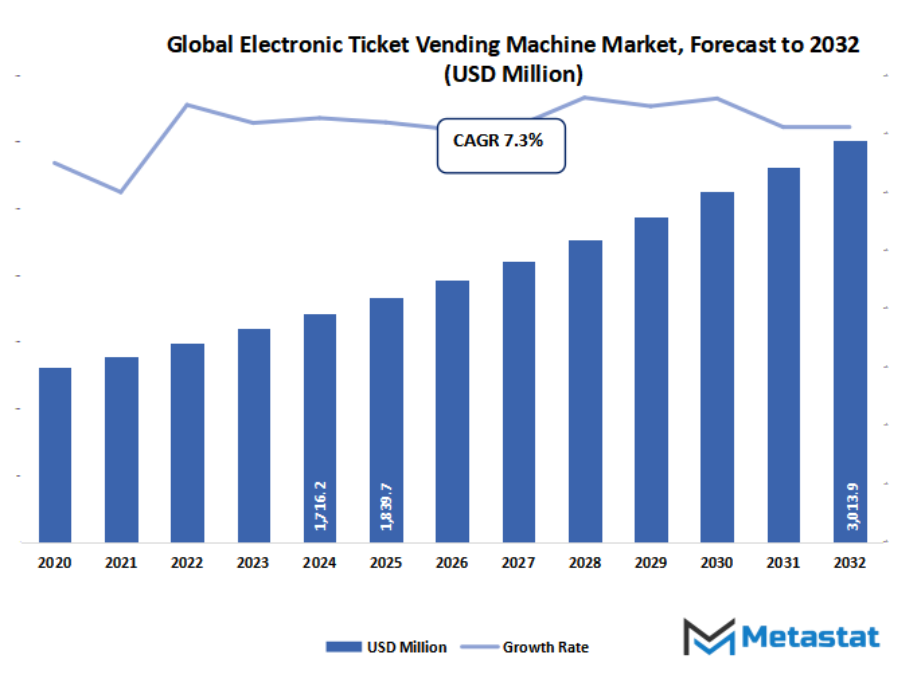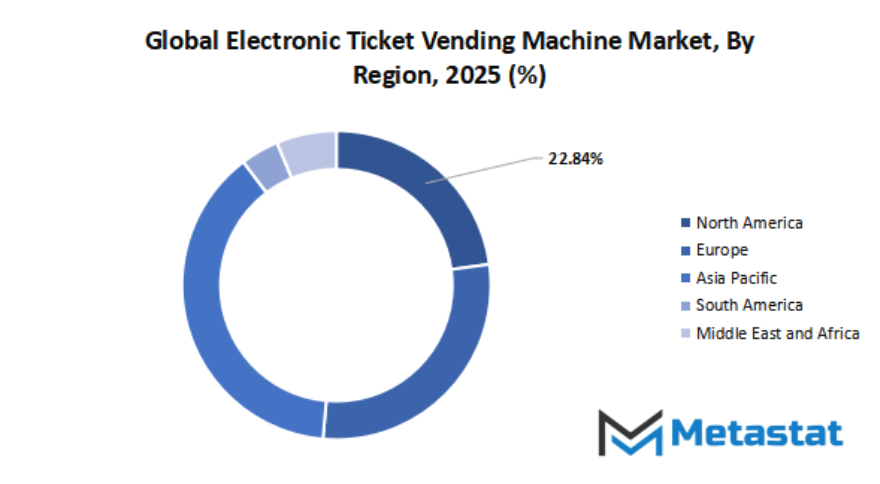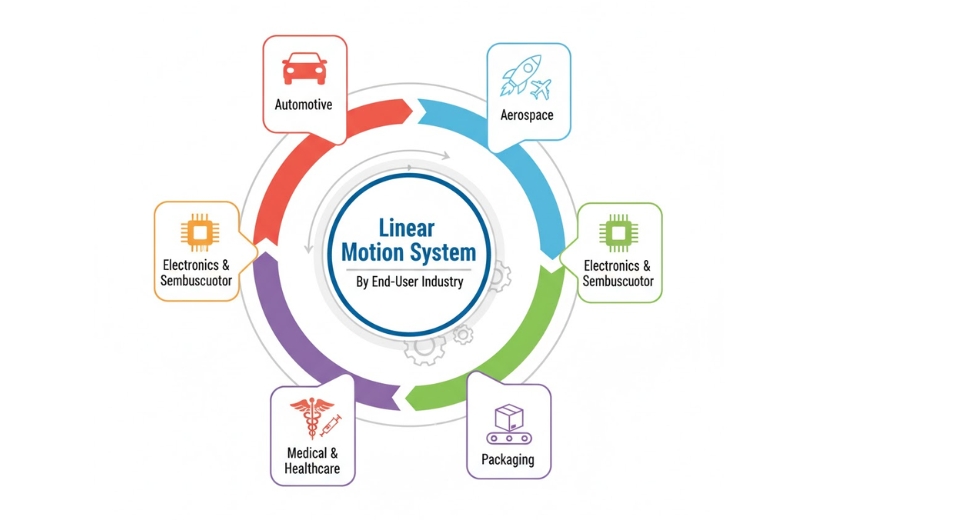Global Electronic Ticket Vending Machine Market - Comprehensive Data-Driven Market Analysis & Strategic Outlook
- Global electronic ticket vending machine market valued at approximately USD 1839.7 million in 2025, growing at a CAGR of around 7.3% through 2032, with potential to exceed USD 3013.9 million.
- Smart Ticket Vending Machines account for a market share of 44.5% in 2024, driving innovation and expanding applications through intense research.
- Key trends driving growth: Rising adoption of smart public transportation systems boosts demand, Increasing need for contactless and cashless transactions supports growth
- Opportunities include: Integration with mobile ticketing and digital payment platforms creates growth opportunities
- Key insight: The market is set to grow exponentially in value over the next decade, highlighting significant growth opportunities.

Market Background & Overview
The global electronic ticket vending machine market and its business will keep on moving beyond the realms of conventional ticket dispensing systems, creating a world where convenience and accessibility will no longer be a choice but a norm. This market will not only find its application in transportation centers or amusement parks but will find its way into more general lifestyle areas where rapid contactless interaction becomes part of everyday life. The travel of this business will go beyond merely providing a machine to dispense a ticket; it will become a highly advanced web in which digital integration and personalization of the user will come first.
In the coming years, the global electronic ticket vending machine market will have its horizon expanded by alliances between technology and services sectors. Machines won't be single-functional kiosks but interactive hubs part of smart infrastructure, well-integrated into mobile platforms, digital wallets, and cloud systems. This expansion will make the machine in the future less about the purchase process and more about facilitating easy mobility and value-added customer experience.
One more aspect that will characterize the future of this market is the way it will suit different cultural and regional requirements. From urban cities to semi-urban environments, the machines will change to meet different demands, with multilingual interfaces, localized offerings, and adaptive designs. This adaptability will help the market move beyond its traditional image and create a space where technology accommodates human differences.
Market Segmentation Analysis
The global electronic ticket vending machine market is mainly classified based on Product Type, Payment Method, Application.
By Product Type is further segmented into:
- Smart Ticket Vending Machines - Smart Ticket Vending Machines will define the global electronic ticket vending machine market with the ability to offer touchless access, customer guidance based on AI, and biometric authentication. These machines will shorten waiting time, increase security, and offer multilingual options, making the trip of passengers globally faster, safer, and more personalized in terms of ticketing options.
- Non-Smart Ticket Vending Machines - Non-Smart Ticket Vending Machines will remain an integral part of the market in areas with less advanced infrastructure. These types of machines will offer basic ticketing services at low prices, benefiting areas where there is little technological access, making it accessible to communities that need simple, reliable, and cheap ticketing services.
By Payment Method the market is divided into:
- Non-cash Payment Type - Non-cash Payment Type will lead the global electronic ticket vending machine market as contactless cards, QR codes, and mobile payments become common throughout international transit systems. The transition will enhance speed, reduce human contact, and improve accessibility, particularly in urban areas where cashless environments will lay the groundwork for contemporary transport.
- Cash Payment Type - Cash Payment Type will continue to hold significance in the market, particularly in rural and underdeveloped areas. Such machines will continue to be crucial for users who prioritize the use of physical money, keeping the ticketing system universal and inclusive for all without regard to digital payment solution accessibility.
By Application the market is further divided into:
- Subway Stations - Subway Stations will account for high usage in the global electronic ticket vending machine market. The increasing dependence on city metro networks will promote the use of intelligent machines that have the ability to handle heavy passenger traffic, de-congestion, and provide real-time ticketing data, eventually defining the world's future of underground mass transit.
- Railway Stations - Railway Stations will gain from the market as updated ticket systems will make long-distance journeys more convenient. Machines will lighten the load of manual ticketing, ease passenger flow, and make the ride smoother by facilitating both cash and electronic transactions, enhancing accessibility within cities, towns, and cross-border rail networks.
- Bus Stations - Bus Stations will see consistent uptake in the global electronic ticket vending machine market because automated machines will offer low-cost ticketing in busy areas. Machines will make ticketing easier, minimize man errors, and provide easy access for regular commuters, allowing bus networks to still run with efficacy and traveler convenience.
- Airports - Airports will significantly influence the market as automation in aviation expands. Machines can be prepared with multilingual features, smart identity, and bags-linked ticketing to beautify tour reports. This advancement will reduce queues, increase passenger delight, and align airport operations with subsequent-generation digital aviation practices.
- Amusement Parks - Amusement Parks will experience increased opportunities in the market. Machines will streamline entry ticketing, minimize crowd accumulation, and be incorporated within loyalty programs or wristbands. Such systems will make for smoother visitor management while making experiences more enjoyable, eventually turning recreational spots into more linked and structured places.
- Others - Others, such as stadiums, ferry terminals, and cultural centers, will increase the global electronic ticket vending machine market through computerized systems that facilitate crowd control and accelerate entry. The machines will offer flexible payment options and sophisticated security features, making it possible for varied public facilities to adopt computerized, accessible, and efficient ticketing mechanisms.
|
Forecast Period |
2025-2032 |
|
Market Size in 2025 |
$1839.7 Million |
|
Market Size by 2032 |
$3013.9 Million |
|
Growth Rate from 2025 to 2032 |
7.3% |
|
Base Year |
2024 |
|
Regions Covered |
North America, Europe, Asia-Pacific, South America, Middle East & Africa |
By Region:
- Based on geography, the global electronic ticket vending machine market is divided into North America, Europe, Asia-Pacific, South America, and the Middle East & Africa.
- North America is further divided into the U.S., Canada, and Mexico, whereas Europe consists of the UK, Germany, France, Italy, and the Rest of Europe.
- Asia-Pacific is segmented into India, China, Japan, South Korea, and the Rest of Asia-Pacific.
- The South America region includes Brazil, Argentina, and the Rest of South America, while the Middle East & Africa is categorized into GCC Countries, Egypt, South Africa, and the Rest of the Middle East & Africa.
Market Dynamics
Growth Drivers:
- Rising adoption of smart public transportation systems boosts demand - The global electronic ticket vending machine market will witness demand increase as cities increasingly implement data-driven smart public transportation systems. Upcoming infrastructure development projects will be centered on quicker and efficient ticketing, and machines will form a key component of eliminating waiting lines, saving time, and enhancing commuter convenience in growing urban networks.
- Increasing need for contactless and cashless transactions supports growth - The market will grow with increasing momentum for contactless and cashless payments. Secure digital wallets, cards, and QR payments will be the basis of future ticketing solutions. Increased focus on hygiene, ease of use, and lower handling of physical currency will compel governments to invest more in these auto-solutions.
Restraints & Challenges:
- High installation and maintenance costs limit deployment in smaller networks - The global electronic ticket vending machine market will be restricted by challenges in smaller towns and rural areas with constrained budgets. Installation and maintenance will keep on demanding heavy investment, making it more difficult for small transport players to implement these systems in their entirety, hindering broad-based availability and access in such markets.
- Technical glitches and cyber vulnerabilities pose operational risks - The market will be challenged by technical faults and cybersecurity attacks. Future systems are required to mitigate risks of machine failures, software bugs, and hacking. Without robust safety features and periodic updates, disruptions can undermine reliability, impacting passenger confidence and operational effectiveness for transport companies.
Opportunities:
- Integration with mobile ticketing and digital payment platforms creates growth opportunities - The global electronic ticket vending machine market will gain advantage through mobile app integration and sophisticated payment systems. Next-generation machines will integrate efficiently with mobile apps, digital wallets, and cloud-based ticketing. This will generate smoother passenger journeys, promote faster adoption, and provide opportunities for wider global expansion in intelligent transportation.
Competitive Landscape & Strategic Insights
The global electronic ticket vending machine market is influenced by both long-standing international players and rapidly expanding regional companies, each with distinctive strengths in the business. As increasing demand for more intelligent ticketing systems in the public transport system, parking lots, and other mobility services develops, the market remains attractive to investments and innovation. The demand for efficiency, shorter waiting times, and accommodating higher passenger flows in congested transport hubs is what fuels the use of electronic ticket vending solutions. This has opened up space not just for veteran industry giants but also for smaller companies with dedicated, flexible solutions.
Some of the larger companies operating globally include Flowbird Group, Genfare, and Scheidt & Bachmann GmbH, entities with decades-long experience in cooperating with transport authorities to provide cutting-edge automated fare collection systems. These are joined by ICA Traffic, Addsoft Technologies Private Limited, and DUCATI Energia Spa in expanding such systems globally, typically with local requirements in mind. Companies like Sigma SpA and GRG Banking are consolidating their footprint through solutions blending innovation in payment technology with simplicity, demonstrating how varied solutions can coexist in such a competitive market.
Meanwhile, firms like AEP Ticketing Solutions s.r.l, Cubic Transportation Systems, Inc., and Conduent Incorporated remain at the forefront of the market through their bulk contracts and integration capabilities. They tend to provide solutions that address entire city or national transport systems, placing them as key movers in the direction of how millions of individuals use public transport on a daily basis. INIT SE, Indra, and ALMEX GmbH also join the fray by offering their respective strengths in terms of smart mobility, data-based ticketing, and enhanced passenger experience. This combination of international conglomerates and specialist specialists is one of the market's defining characteristics, which makes it dynamic and responsive to new possibilities.
As urbanization intensifies and public transport networks improve globally, market will keep experiencing partnerships among these incumbent giants and local innovators. The business isn't always just about manufacturing machines anymore but about embedding them in cell structures, digital fee technologies, and contactless programs that may meet the expectations of state-of-the-art passengers. With numerous players innovating in phrases of layout, safety, and performance, the marketplace will continue to be competitive, turning in solutions which are faster, smarter, and to be had to greater human beings around the world.
Forecast & Future Outlook
- Short-Term (1–2 Years): Recovery from COVID-19 disruptions with renewed testing demand as healthcare providers emphasize metabolic risk monitoring.
- Mid-Term (3–5 Years): Greater automation and multiplex assay adoption improve throughput and cost efficiency, increasing clinical adoption.
- Long-Term (6–10 Years): Potential integration into routine metabolic screening programs globally, supported by replacement of conventional tests with advanced biomarker panels.
Market size is forecast to rise from USD 1839.7 million in 2025 to over USD 3013.9 million by 2032. Electronic Ticket Vending Machine will maintain dominance but face growing competition from emerging formats.
The future stage of this market will not only define the purchase of tickets but also their experience. By going beyond its scope, the global electronic ticket vending machine market will emerge as a force to be reckoned with that unifies technology and lifestyle, making ticketing more convenient, engaging, and accessible.
Report Coverage
This research report categorizes the global electronic ticket vending machine market based on various segments and regions, forecasts revenue growth, and analyzes trends in each submarket. The report analyses the key growth drivers, opportunities, and challenges influencing the market. Recent market developments and competitive strategies such as expansion, type launch, development, partnership, merger, and acquisition have been included to draw the competitive landscape in the market. The report strategically identifies and profiles the key market players and analyses their core competencies in each sub-segment of the global electronic ticket vending machine market.
Electronic Ticket Vending Machine Market Key Segments:
By Product Type
- Smart Ticket Vending Machines
- Non-Smart Ticket Vending Machines
By Payment Method
- Non-cash Payment Type
- Cash Payment Type
By Application
- Subway Stations
- Railway Stations
- Bus Stations
- Airports
- Amusement Parks
- Others
Key Global Electronic Ticket Vending Machine Industry Players
- Flowbird Group
- Genfare
- Scheidt & Bachmann GmbH
- ICA Traffic
- Addsoft Technologies Private Limited
- DUCATI Energia Spa
- Sigma SpA
- GRG Banking
- AEP Ticketing solutions s.r.l
- Cubic Transportation Systems, Inc.
- Conduent Incorporated
- INIT SE
- Indra
- ALMEX GmbH
WHAT REPORT PROVIDES
- Full in-depth analysis of the parent Industry
- Important changes in market and its dynamics
- Segmentation details of the market
- Former, on-going, and projected market analysis in terms of volume and value
- Assessment of niche industry developments
- Market share analysis
- Key strategies of major players
- Emerging segments and regional growth potential









 US: +1 3023308252
US: +1 3023308252






